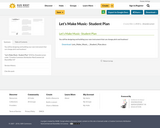
You will be designing and building your own instrument that can change pitch and loudness!
- Subject:
- Arts Education
- Material Type:
- Homework/Assignment
- Date Added:
- 10/01/2018

You will be designing and building your own instrument that can change pitch and loudness!

Today we're going to take a hike up Mt. Kilimanjaro so we can talk about how the geosphere changes based on many different things. On the same mountain we can travel through many different habitats like rain forests, savannas, and moorlands. Let's take a walk with Sabrina and see how!
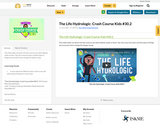
This video takes use down into the ocean to see what habitats await us there. Yep, the ocean has layers and the types of things we encounter there change the deeper we go.
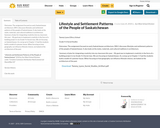
Outcomes:
The assignment focused on early Saskatchewan architecture.
DR4.1 discusses lifestyles and settlement patterns of the people of
Saskatchewan. It also looks at the styles, materials, and cultural
traditions in architecture.
Summary of plan for integrating creativity into my classroom this
year:
- My goal was to implement creativity in the form of a building
project in my Grade 4-6 Social class. We are focusing on
Saskatchewan. As a wrap up to Chapter 1 I had the students
build a model of a pioneer house. When focusing on how
geography can influence lifestyle choices, we looked at the
architecture of the past.
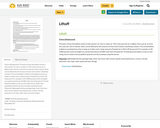
Science Background:
The basis of how the balloon works is that warmer air rises in cooler air. This is because hot air is lighter than cool air as it has less mass per unit of volume. Mass can be defined by the measure of how much matter something contains. The actual balloon (called an envelope) has to be so large as it takes such a large amount of heated air to lift it off the ground. For example, to lift 1000 pounds worth of weight you would need almost 65,000 cubic feet of heated air! To help keep the balloon in the air and rising, hot air needs to be propelled upwards into the envelope using the burner.
Materials: lightweight kitchen garbage bags, timer, hair dryer with various speeds and temperatures, scissors, thread, extension cord, tape, other types and sizes of bags
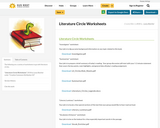
The folloeing are a variety of worksheets to go with literature circles.

For my artifact, I incorporated literature circles into the reading of the novel, Lord
of the Flies. The first step in this process was to introduce the roles to the students and
to explain what was expected of them. Then, I split the students into their groups of four
using a random group generator (groups can be adjusted based on numbers, but four
worked best in my class). Once students knew what was expected of them, they talked
with their group members to determine who was doing what role for the first two
chapters. From there, we would read two chapters and I would allow the students time
to complete their role sheet (I also encouraged them to do this as they were reading
along, especially for quotes and vocab) and then they would meet with their group to
share their role with the other members. As the teacher, I would circulate between the
groups while they were sharing to listen to them and to provide any input/clarifications.
We would then repeat this process after each two chapters (there are 12 chapters in
total in the novel).

Science Background: All organisms interact, and a key science concept for students to understand is that all organisms affect each other and are affected by each other. Getting rid of a certain species like mosquitoes disrupts the entire food chain, and this simulation allows them to start thinking about the ecosystem in a big picture way.
Materials: Pinnies or some other way of distinguishing teams, Large playing field, Timer
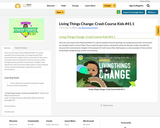
Have you ever heard of the Peppered Moth? It's a great example of how living things can change because their environment has changed. And it's not just them! There used to be giant insects roaming the world, but they got smaller through time because their environments changed. In this episode of Crash Course Kids, Sabrina gives us some examples of how and why living things change because of their environments.

Plants! We absolutely depend on them. Oxygen, food, and looking super nice to boot! But, plants have a lot more going on than meets the eye. How do we know that? Investigations and Experimentations!
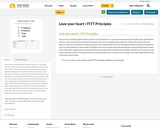
If your heart is healthy it will be able to work for a very long time.
It is up to you to keep your heart healthy.
Your heart will like it if you:
1. Exercise every day
You need to exercise your heart by making it work harder for at least 30
minutes a day. Our topics on 'Fitness' and 'Exercise' will show you how
2. Eat a healthy diet
Too much fatty food will block up the arteries with fat and your heart will
have to work harder and harder just to do its regular job of pumping
blood round your body. See our topics in the 'Your food' category to learn
about the foods your body needs and what your heart likes
3. Drink lots of water every day rather than fizzy drinks
4. Make good choices as you grow older. You can choose not to smoke, not
to take illegal drugs and not to drink too much alcohol
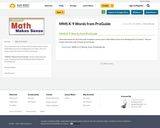
These documents list all of the math vocabulary words used in Math Makes Sense from Kindergarten to Grade 9. They are broken down into units of study for each grade.
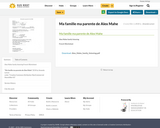
Alex Mahe family listening
French Worksheet
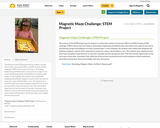
The purpose of this STEM project was for student’s to show their mastery of outcomes ME3.1 and ME3.2 using a STEM challenge. STEM is the acronym for Science, Technology, Engineering and Mathematics and requires the usage of each area in the planning, design and building of an inquiry-based project. In this challenge, the students were tasked with designing and building a magnetic maze for their classmates to maneuver a paper clip through in a race. The students were required to plan their maze and gather materials prior to class then assemble and test during class time. They then had the opportunity to test the mazes of two other classmates. Post-reflection of the activity involved discussion and evaluation of what worked and what didn’t and the best ideas and strategies that were discovered.
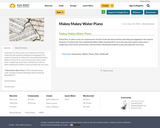
Action Plan: To add an active, fun component for Arts Ed. Grade One that would be motivating
and engaging for the students.
Summary: To achieve this I have adapted the Makey Makey invention kit for use in the shop
and created a water piano. I taught basic music theory and the basic scale first before allowing
the students to play and make their own music.

Making Math More Fun offers lots of games and activities that get students excited about practicing math skills.
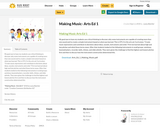
My goal was to have my students use critical thinking to discover why some instruments are capable of creating more than one sound and to create a simple instrument based on what was learned. This is CP1.5 in the arts ed. Curriculum. “Create music expressions and contribute to decisions about ideas, sounds, instruments and order.” First we learned about high and low pitches and what those terms mean. After that students looked at the following instruments in small groups: autoharp, boomwhackers, recorder, bells, chimes, and slide whistle. They were given the challenge to find the highest and lowest pitches first and then to discuss how the instrument construction determined this.

All students learn differently. It is important to understand
the thought processes of all students. I wanted to use the
class blog to demonstrate my students’ thinking and increase
their engagement. I worked with all the different areas of
learning styles presented at this PD day. I created different
assignments and I had the students put their work on our
class blog.

All students learn differently. It is important to understand the thought processes of all students. I wanted to use the class blog to demonstrate my students’ thinking and increase their engagement. I worked with all the different areas of learning styles presented at this PD day. I created different assignments and I had the students put their work on our class blog

Directions on making a math journal